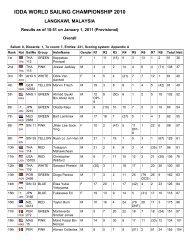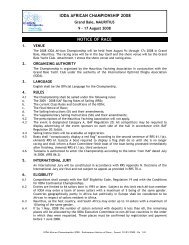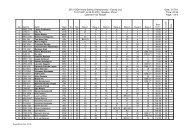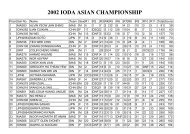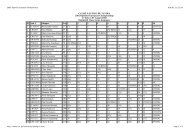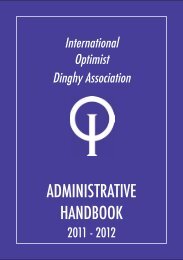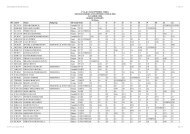2011 INTERNATIONAL OPTIMIST CLASS RULES
2011 INTERNATIONAL OPTIMIST CLASS RULES
2011 INTERNATIONAL OPTIMIST CLASS RULES
Create successful ePaper yourself
Turn your PDF publications into a flip-book with our unique Google optimized e-Paper software.
individually by lifting the side of the boat (or the transom in the case of the aft straps) off<br />
the ground. Finally the bags should be replaced in the boat, re-inflated and the straps<br />
checked to ensure that the bag is held securely in place.<br />
3.2.7.6 The first buoyancy test shall normally be completed at the time of the first measurement<br />
of the boat. However, if the measurer certifies that the buoyancy test could not be taken<br />
at that time, but in all other respects the Class Rules are satisfied the measurement<br />
certificate may be issued but with the endorsement “Not valid until a buoyancy test has<br />
been passed.”<br />
3.2.8 Weight<br />
3.2.8.1 The weight of the hull in dry condition,<br />
including: rudder gudgeons fixed to the aft transom, buoyancy straps, toe straps and<br />
associated fixings (without removable foam or protection), mast step, block fittings permanently<br />
attached, but excluding: corrector weights, blocks, mainsheet, buoyancy air<br />
bags, painter, bailer, paddle, compass (with bracket if any) and fixings, retaining clips for<br />
water bottles, food containers or other personal equipment and fixings, and all other not<br />
specifically permitted items, shall not be less than 32 kg.<br />
3.2.8.2 If the weight of the hull in the same condition as prescribed in CR 3.2.8.1 but including<br />
buoyancy air bags is less than 35 kg but not less than 32.6 kg wood corrector weights<br />
shall be fitted to bring the hull weight up to not less than 35 kg. The corrector weights<br />
shall be permanently fitted, half to the forward transom and half to the aft transom. No<br />
corrector weights shall be removed or altered without the boat being re-weighed by an<br />
official measurer. The weight of each corrector shall be stamped or otherwise marked on<br />
the corrector and endorsed on the measurement certificate.<br />
(See also CR 3.2.7.1 for minimum weight of buoyancy air bags.)<br />
3.3 Daggerboard<br />
3.3.1 Materials<br />
3.3.1.1 The daggerboard shall be made of either wood or EPOXY as specified below<br />
Wood:<br />
Plywood<br />
Glue<br />
Paint<br />
Wood<br />
Asingle sheet of commercially available plywood shall be used. Manufacturers<br />
shall, upon request, supply a sample and specification sheet of plywood used.<br />
Epoxy, for bonding battens to the daggerboard only.<br />
Clear varnish or clear epoxy, suitable for marine use.<br />
Any type, for battens only<br />
EPOXY:<br />
Resin<br />
Epoxy resin for EPOXY lamination (shall not be coloured)<br />
Foam Core Durable, non-absorbent closed cell PVC foam. 13mm (+/- 10%),<br />
60 Kg/m3 (+/- 10%)<br />
Unidirectional 600 Unidirectional mat of E glass fibres, 600 gr/m2 (+/- 10%)<br />
Woven cloth 280<br />
Mat 100<br />
Glue<br />
Gelcoat<br />
Wood<br />
Cloth of woven or otherwise biaxial applied skeins of continuous E glass<br />
fibres 280 gr/m2 (+/- 10%). Pre-impregnated cloth is not permitted.<br />
Chopped strand mat of E glass fibres, 100 gr/m2 (+/-10%) (shall<br />
not be coloured)<br />
Epoxy, for bonding battens to the daggerboard only.<br />
Shall be clear<br />
Any type, for battens only<br />
14



